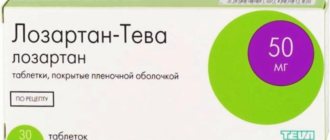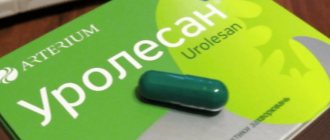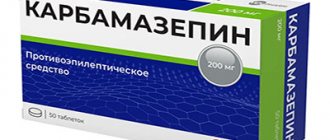Registration number: R N001049/02 dated 12/12/2007 Tradename: CYCLOFERON® (СYCLOFERON®) Dosage form: enteric-coated tablets Group name: meglumine acridone acetate
Composition of the drug Pharmacological properties Indications for use Contraindications
Directions for use and dosage Side effects Interaction with other drugs
Pharmacological properties
Pharmacodynamics
Cycloferon is a low-molecular-weight interferon inducer, which determines a wide range of its biological activity (antiviral, immunomodulatory, anti-inflammatory, etc.). Cycloferon is effective against herpes viruses, influenza and other pathogens of acute respiratory diseases. It has a direct antiviral effect, suppressing viral reproduction in the early stages (days 1–5) of the infectious process, reducing the infectivity of viral offspring, leading to the formation of defective viral particles. Increases the body's nonspecific resistance to viral and bacterial infections.
Pharmacokinetics
When taking a daily dose, the maximum concentration in the blood plasma is reached after 2–3 hours, gradually decreases by the 8th hour, and after 24 hours Cycloferon is detected in trace amounts. The half-life of the drug is 4–5 hours, so its use in recommended doses does not create conditions for accumulation in the body.
Cycloferon: dosage regimen for adults
For respiratory pathologies, it is recommended to take the medicine in a single dose on the 1st, 2nd, 4th, 6th, 8th day (20 tablet forms are required). Therapy should be started when the first signs of the disease appear. This will increase the effectiveness of treatment. If the disease is severe, you need to drink 900 mg on the first day of therapy, and then take a standard single dose on the remaining days. To alleviate the condition, it is recommended to use cough and fever medications along with Cycloferon.
Herpetic infection is treated according to the following scheme: single dosage on days 1, 2, 4, 6, 8, 11, 14, 17, 20, 23. For therapy you will need 40 tablet forms.
Adults can use Cycloferon to prevent respiratory diseases. It is better to check the treatment regimen with your doctor.
Cycloferon, 150 mg, enteric-coated tablets, 20 pcs.
Polisan, Russia
Price from 377₽
Cycloferon, 150 mg, enteric-coated tablets, 10 pcs.
Polisan, Russia
Price from 191₽
Cycloferon, 5%, liniment, 5 ml, 1 pc.
Polisan, Russia
Price from 164₽
There are contraindications. Specialist consultation is required.
How to take Cycloferon for HPV
The causative agent of HPV can have low or high oncogenicity (the ability to cause cancer). Weakly oncogenic microorganisms can provoke warts on the skin. Strongly oncogenic strains more often cause the formation of genital warts.
For warts, Cycloferon tablets can be used for 2 weeks. For HPV affecting the genital organs, the injection form of the drug is most often indicated. If HPV symptoms appear, you should visit a dermatologist (as well as a urologist or gynecologist if the genital organs are affected). The doctor will tell you whether you can take Cycloferon and prescribe the correct therapy. You should not treat the disease yourself.
Directions for use and doses
Orally once a day 30 minutes before meals, without chewing, with ½ glass of water, in age-specific dosages:
- children 4–6 years old: 150 mg (1 tablet) per dose;
- children 7–11 years old: 300–450 mg (2–3 tablets) per dose;
- adults and children over 12 years of age: 450–600 mg (3–4 tablets) per dose.
It is advisable to repeat the course 2–3 weeks after the end of the first course.
In adults:
- When treating influenza and acute respiratory diseases, the drug is taken on days 1, 2, 4, 6, 8 (course of treatment - 20 tablets). Treatment should begin at the first symptoms of the disease. For severe flu, take six tablets on the first day. If necessary, additional symptomatic therapy is carried out (antipyretics, analgesics, expectorants).
- For herpes infection, the drug is taken on days 1, 2, 4, 6, 8, 11, 14, 17, 20, 23 (course of treatment - 40 tablets). Treatment is most effective when the first symptoms of the disease appear.
In children from four years of age:
- For influenza and acute respiratory diseases, the drug is taken in age-specific doses on days 1, 2, 4, 6, 8, 11, 14, 17, 20, 23. The course of treatment ranges from 5 to 10 doses, depending on the severity of the condition and the severity of clinical symptoms.
- For herpes infection, the drug is taken on the 1st, 2nd, 4th, 6th, 8th, 11th, 14th day of treatment. The course of treatment may vary depending on the severity of the condition and the severity of clinical symptoms.
- For emergency nonspecific prevention of influenza and acute respiratory diseases (in direct contact with patients with influenza or acute respiratory infections of another etiology, during an influenza epidemic): on the 1st, 2nd, 4th, 6th, 8th day. Next, take a break of 72 hours (three days) and continue the course on the 11th, 14th, 17th, 20th, 23rd day. The general course is from 5 to 10 doses.
Instructions for use of Cycloferon tablets
The medication is indicated for use orally. You should take the tablets half an hour before meals. The tablet form should not be chewed, as it has a protective coating that does not allow the active substance to be destroyed by gastric juice. The tablet shell dissolves only in the intestinal cavity, which increases the effectiveness of the drug.
Take the tablet with 50 ml of water. Depending on age, different dosages are used:
- adults - single dose 450-600 mg;
- 7-11 years of age - single dosage 300-450 mg;
- 4-6 years - single dose 150 mg.
Repeated course therapy is carried out 14-21 days after the end of the first course.
Side effects
According to the World Health Organization, adverse effects are classified according to their frequency as follows:
– very frequent (≥ 1/10); – frequent (≥ 1/100 – < 1/10); – uncommon (≥ 1/1000 – < 1/100); – rare (≥ 1/10000 – < 1/1000); – very rare (< 1/10000); – frequency unknown (cannot be determined based on available data). Immune system disorders: very rarely - angioedema. Disorders of the skin and subcutaneous tissues: very rarely - rash, urticaria. If any of the undesirable effects indicated in the instructions get worse or you notice any other undesirable effects not listed in the instructions, tell your doctor.
Action of Cycloferon
Interferons are proteins formed in the human body to fight viruses and microorganisms. The drug will effectively cope with influenza, bronchitis, pneumonia, herpes, hepatitis, chlamydia, and chronic bacterial and fungal infections. Prevents the development of complications in the body. It is used even for cancer and the initial stages of HIV disease.
It often happens that someone’s birthday or holiday coincides with the disease. You need to know whether Cycloferon is compatible with alcohol, and whether it will cause harm to health in combination with it. The contraindications in the instructions are brief; there are no warnings for the combination.
Composition and dosage forms
The active substance of the drug is meglumine acridone acetate - acridone acetic acid. It is a stimulator of interferon production, which has an antimicrobial, anti-inflammatory effect and inhibits the development of tumors.
Cycloferon is produced in forms for oral, parenteral and local use:
- Coated tablets: brown or yellow, biconvex. The composition includes: 150 mg of active substance, methylcellulose and calcium stearate as auxiliary compounds. Packages contain 10 and 50 pcs.
- Injection. Transparent yellowish liquid in 2 ml ampoules. The content of meglumine acridone acetate is 250 mg per ampoule. Additional components: water and stabilizers.
- Liniment for topical use: a thick, gel-like yellow substance containing 5% active substance. Available in 5 ml tubes.
Indications
Cycloferon is used in patients from 4 years of age:
- in the treatment of herpetic infections;
- for neuroinfections;
- cytomegalovirus;
- intestinal inflammation of a viral nature;
- for the treatment of acute respiratory viral infections, acute respiratory infections;
- in the complex treatment of viral hepatitis, HIV.
Liniment is used in the treatment of urogenital infections. The solution is also indicated for chlamydia and connective tissue diseases.
Taking drugs and alcohol together
Some people ask: “Can this drug be combined with alcohol?” - any substances must be combined with caution. Some try to cure the flu at home with vodka or hot beer - don’t risk it, take the medications prescribed by your doctor.
What happens to the liver and kidneys
It is contraindicated for pregnant women, breastfeeding, children under 4 years of age, and for severe liver and kidney diseases. If you have problems with the liver or kidneys, doctors do not recommend this combination, since the effect on these organs is detrimental. When drinking ethanol, liver cells are destroyed. They are replaced by adipose and connective tissue. Subsequently, liver function is disrupted, diseases and pathologies of this organ occur, and cirrhosis is possible. Cycloferon puts a lot of strain on the liver and kidneys, as does alcohol. The kidneys will have to remove both from the body, this increases their workload. Alcohol itself is a poison for the body; it is toxic. The danger is that liver disease goes unnoticed; the disease can only be detected by passing certain tests.
Increased intoxication
It is forbidden to drink alcohol for diseases treated with Cycloferon, for viral and bacterial infections with intoxication, drinking alcohol slows down recovery. Side effects in case of non-compliance with the dosage of Cycloferon (exceeding) and increased intoxication due to ethanol:
- fatigue;
- nausea;
- vomit;
- diarrhea;
- headache, dizziness, migraine;
- pain in the abdomen, muscles.
Effect on the nervous system
Imagining that all these actions will intensify a couple of times, because hangover symptoms are similar, it is better not to risk your health. If a person is aggressive and irritable, when Cycloferon and alcohol are compatible, the symptoms will intensify. The central nervous system is loaded, and alcohol has a relaxing effect - which has a detrimental effect. Available:
- chills,
- weakness,
- drowsiness,
- memory loss,
- deep depression.
Decreased immunity
Alcohol has a destructive effect on the immune system, which increases the incidence of viral diseases; abuse will minimize the effect of the drug. Cycloferon, on the contrary, increases the productivity of the immune system. If you drink cycloferon and alcohol together, the following happens in the body:
- the load on the liver will increase;
- immune activity will decrease;
- the effect of treatment will decrease;
- the risk of recurrent bacterial disease increases.
If you drink alcohol and Cycloferon at the same time, you may experience: nausea, vomiting, dizziness. Also observed: loss of appetite, headache, increased heart rate, depression.
In general, reviews of Cycloferon as a drug are positive, there are no such contraindications in the instructions, the drug is not an antibiotic. Patients conclude that it is possible to combine. In any case, you need to consult a doctor and only then draw conclusions.
Cycloferon for genital herpes
In addition to systemic therapy, applications with Cycloferon liniment are used:
- a thin layer of the product is applied to the affected areas daily for 5–7 days;
- use the drug for intravaginal or transurethral instillation, injecting 5 ml daily for 2 weeks;
- cotton swabs soaked in ointment are inserted into the vagina for 10–15 days.
Cycloferon ointment can be alternated with the use of other topical drugs.
Contraindications
It is necessary to refuse treatment with the drug:
- with uncompensated cirrhosis;
- severe liver failure;
- individual intolerance to components;
- development of an allergy to the drug.
The medicine is also prohibited for the treatment of children under 4 years of age.
Those suffering from diseases of the gastrointestinal tract need to monitor their well-being when using tablets. In case of disturbances in the functioning of the endocrine system, treatment requires special care and medical supervision.







